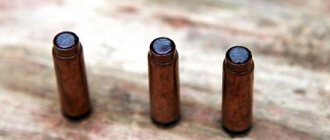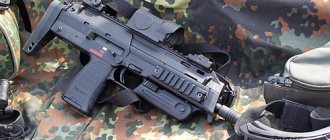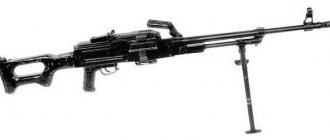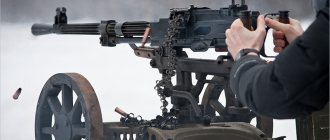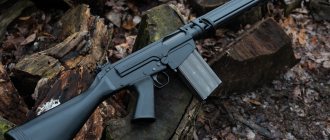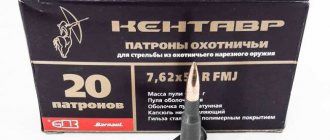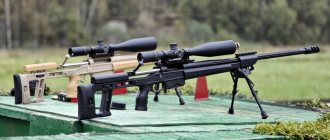| .270 Winchester | |
| Chuck type | Rifle/hunting |
| Manufacturer country | USA USA |
| Production history | |
| Constructor | Winchester |
| Time of creation | 1923 |
| Manufacturer | Winchester |
| Years of production | 1925–present |
| Characteristics | |
| Chuck length, mm | 85 |
| Real bullet caliber, mm | 7 |
| Bullet weight, g | 5…9 |
| Initial bullet speed, m/s | 900…1100 |
| Bullet energy | 2500…3700 |
| Sleeve parameters | |
| Sleeve length, mm | 64,5 |
| Sleeve shoulder diameter, mm | 11,2 |
| Sleeve base diameter, mm | 11,94 |
| Sleeve flange diameter, mm | 12 |
| .270 Winchester at Wikimedia Commons | |
The .270 Winchester
is a popular hunting rifle cartridge.
History of creation
The .270 Winchester cartridge was developed by the famous American arms company Winchester in 1923 and put into mass production in 1925. The company initially planned to adapt one of its models of repeating carbines (Winchester Model 54)[1] for it.
The designers were faced with the task of achieving maximum direct shot range with minimal recoil. When using standard 7.62 mm caliber cartridges, this was difficult to achieve, since the recoil was much stronger than required. A solution was found by reducing the caliber to 0.270 inches, that is, 7. The developers decided not to invent a new cartridge case, but to adapt the cartridge case from the .30-06 military rifle cartridge, which was widely used at the beginning of the 20th century, squeezing it into the barrel.
The result was a cartridge that fully corresponded to the task. Thanks to a very high initial velocity (up to 1000 m/s and even more), the bullet of the .270 Winchester cartridge acquired an extremely flat trajectory, which sharply increased the direct shot range compared to other cartridges available at that time, and the recoil was just as low. However, in the first decades of its existence, the cartridge was not widely known. The .270 Winchester cartridge really gained international popularity after World War II.[1] Now it is one of the most widely used cartridges in the USA and Europe, although in Russia it is still relatively little known.
Cartridge for cold laser sighting cal. .30-06 Spr SightMark SM39003
Cartridge for cold laser sighting cal. .30-06 Spr SightMark SM39003
Laser cartridge Yukon Sight Mark 30-06, 25-06 REM Laser Bore Sights is an independent, ready-to-use product.
Allows you to zero or check the zeroing of hunting weapons without firing cartridges. This is especially true when using expensive ammunition. You can fine-tune any sights on your weapon during the “cold” zeroing stage. It is impossible not to note another useful function of these laser sighting cartridges - the ability, right before a hunt, to very quickly check whether your well-aimed optical sight has gone astray during transportation. Remember that misses are not uncommon for this reason. The light weight and shape of the cartridge are convenient to use and do not take up much space in the equipment of the shooter and hunter. Specifications:
Used for zeroing rifled carbines of calibers .30-06, 25-06 REM , .270 WIN , .30-06 SPR , .308 WIN , 8-06 , .338-06 , .35 WHELAN , .280 REM , 7mm EXPRESS , 7.7×58 JAPANESE . Laser type: red semiconductor ( Visible Red Laser ). The wavelength of laser radiation is 632-650 nm . Emitter power less than 5 mW . Operating modes ON / OFF ( On / Off end cap ). “Sighting” distance from 13.7 m ( 15 yards ) to 183 m ( 200 yards ). The maximum distance depends on lighting conditions. The optimal shooting distance is from 13.7 m ( 15 yards ) to 91.44 m ( 100 yards ). The spot size at a distance of 91.44 m (100 yds) is approximately 50 mm (about 2″) . The non-parallelism of the laser beam to the barrel axis is 0.0005 radians. Power source: 2 batteries LR48/AG5 1.5V or 3 batteries LR41/AG3 1.5V ( 1 hour of continuous operation). The material of the cartridge body is brass . Weight is about 100 g. Operating temperature range is from -10 to +50 degrees C.
Applications of Laser Bore Sights:
The system is absolutely independent of the type of weapon and is “tied” only to the caliber. Standard zeroing distance is 22.9 meters (25 yards) . Place a target at this distance for shooting. Target dimensions: 140 mm x 140 mm. The target division value is 25 mm.
If necessary, secure the weapon in a sighting vise, place it on a bipod, or place it on a resting surface. Unscrew the bottom of the Laser Bore Sights counterclockwise.
Insert the batteries into the plastic container, observing the polarity.
Insert the red plastic container (insulator) into the laser module (cartridge) and screw the bottom clockwise without much effort. The laser beam will burn continuously.
Attention: Be careful when using the laser cartridge to avoid damage to your eyes.
Attention: It is forbidden to look towards the beam, direct radiation into a person’s eye, or place foreign objects in the path of the laser beam that cause its mirror reflection.
Attention: When installing batteries, observe the correct polarity. Insert the powered laser model into the chamber of a rifle or shotgun of the appropriate caliber (on bolt-action carbines, the bolt must be closed). Align the laser dot of the sighting cartridge with the center of the target. When zeroing at a distance of 25 meters, the aiming mark of the optical sight is aligned with the laser dot projected at the center of the target. The weapon is zeroed by aligning the aiming line with the axis of the barrel at a given distance. The position of the center of the light spot corresponds to the weapon's midpoint of impact (MIP), without taking into account the ballistics of the bullet's flight path. Align the aiming line of the open sighting device of the weapon or sighting devices installed on it: optical, collimator sights, laser designators, luminous front sights and rear sights with the center of the light spot of the laser cartridge. When the laser beam deviates from the center of the target by 30 or 50 mm or another greater value, use the windage and elevation adjustment drums on your scope to begin adjusting the reticle of your scope to the correct position. This is done by clicking on your crosshair. Zeroing is considered complete if the crosshair of the weapon's sighting device is aligned with the center of the laser emitter spot aimed at the object.
Note: If, in the process of adjusting the sighting devices, you aim at the center of the laser dot, then the bullet will hit the same spot only at those distances where the trajectory decrease is 0, for example 100 m. Therefore, if you plan to use the weapon at a longer or shorter distance, you must take into account the change in trajectory in accordance with the ballistic tables for a given ammunition. Remove the laser cartridge from the chamber. By turning the bottom of the sleeve counterclockwise, turn off the laser, or remove the batteries from the Laser Bore Sights.
Instructions for use and storage:
Caution: Remove the batteries from the Laser Bore Sights when not in use for an extended period of time. Deteriorated batteries can destroy the device. The device requires careful and careful handling. According to the degree of radiation hazard, the device belongs to class 2 CH 5804-91. The Laser Bore laser sighting module must be stored in a clean room at a temperature of +5 to + 40 degrees C and a relative air humidity of no more than 60%. (At air temperatures below +25 degrees C, the relative humidity can be increased to 80%.) The air in the room should not contain impurities that cause corrosion of metals and deposits on the surfaces of optical instruments.
Scope of delivery:
Laser cartridge Laser Bore Sights 25-06 REM 1 pc. Power supplies LR48/AG5 2 pcs (or LR41/AG3 3 pcs). Cordura case for storage and transportation 1 pc.
Product packaging is blister.
Measurement data for the Laser Bore Sight module is based on SAAMI instructions. The NORTH AMERICAN HINTING CLUB gave its high marks to these cartridges after extensive testing. Manufactured by YUKON OPTIC USA.
Features and Applications
The .270 Winchester cartridge proved to be extremely convenient for hunting small and medium game, especially in conditions where long-range shooting and high weapon accuracy were required. The high flatness of the bullet trajectory allows effective shooting at 300-400 m.
At close ranges, .270 caliber bullets have a powerful blast effect on impact. This should be taken into account when shooting at small game, the carcass of which can be severely torn by a bullet.[2][3][4]
The .270 Winchester cartridge is very popular in the USA, where deer hunting is common. In Europe, it is also well suited for deer, small and medium-sized wild boar, and, with a light bullet, for roe deer and even fox[5]. It can also be used in Africa for shooting small and medium-sized ungulates. But for larger animals (elk and bear in Europe and North America, zebras, wildebeest and elands in Africa, and in general any game weighing more than 200), the killing power of this cartridge is insufficient.
This cartridge is very good for hunting in the mountains, when hunting chamois, mountain sheep, etc., since mountain hunting requires long-range and accurate shooting, and the size of the game fully corresponds to the capabilities of the .270 Winchester cartridge.
Another important reason for the popularity of this cartridge is its comparative cheapness. This makes it suitable for sports shooting, when the consumption of ammunition is in the tens. In Russia, the price of one cartridge is approximately 50-70 rubles.
M1 Garand rifle - video
After John Garand received a patent for the final model of his design in 1930, his rifle was submitted for consideration two years later for introduction into service as the main weapon of the American Army. The rifle of the Garand design had a caliber of 7 mm, or according to the American classification .270. This was the reason that the rifle did not even pass the first stage of the competition, since US military officials were clearly against this cartridge, and demanded a larger caliber weapon using the .30-06 cartridge (7.62x63 mm). As a result, the design of the rifle was adapted for the .30-06 cartridge, and in 1936, after several upgrades, the Garand rifle was adopted by the US Army under the name “US rifle .30 caliber M1”. Since the 37th year of the last century, the M1 Garand began to arrive in large quantities to the US Army, where it caused a lot of criticism.
M1 Garand rifle - right and left views
The first rifles, by analogy with the first “pancakes lumpy,” worked extremely poorly. The soldiers complained that after six shots the rifle began to produce wedges of various types, and most often the number “six” was voiced regarding the last shot before the delay. This incident with a rifle on which great hopes were pinned, of course, reached the US Congress. After investigations carried out by military officials of the North American states on the urgent recommendations of Congress, it was decided that it was necessary to modify the mechanism of the gas exhaust system, which was considered flawed, because gunsmiths saw it as the reason for the delays in automatic operation when firing.
In 1939, the rifle was modernized, and the best personnel of the US arms industry took part in this modernization, who eliminated many shortcomings, both in the operation of the automatic equipment of the new rifle and in handling it. After a series of upgrades, the rifle again went through the entire cycle of field army tests, after which this weapon entered large-scale mass production and, since 1941, has been produced in tens of thousands of units. Before this, M1 rifles were produced in relatively small quantities, due to flaws in the mechanisms. Old M1 rifles, manufactured before modernization, were remade to new standards.
M1C Garand rifle with M81 sniper scope
The main reason for this approach and the sharp increase in the number of M1 rifles produced is clearly visible in the date - 1941. It was then that it became clear to the whole world that the Wehrmacht troops would not limit themselves to the enslavement of small European states, but on the contrary, having received from them material and human resources (as free labor), the army of Nazi Germany and its allies would be the initiators of aggression throughout the globe, which cannot but affect the interests of the United States of America. Therefore, the country, or rather its army, urgently needed a powerful self-loading rifle, because at that time in the arsenal of the countries participating in the Second World War there were predominantly non-automatic rifles with manual reloading, with a “bolt” bolt. Most of the soldiers of the Red Army were armed with Mosin rifles and carbines, the Mauser 98 rifle and the Mauser 98k carbine were the main weapons of the Wehrmacht, the English Lee-Enfield rifle formed the basis of the small arms of the British army. In other words, most of the small arms that played a decisive role in World War II were non-self-loading rifles, they were bolt-action rifles that had to be manually pulled for each subsequent shot.
In those terrible years, the war posed a serious danger to the foundations of US statehood and independence, which the people of this country value so much. Therefore, the participation of the United States in the massacre unleashed by Germany was inevitable, and for this, of course, an effective weapon was required, which should have higher combat characteristics compared to the weapons of opponents, as well as allies (you never know, allies often become opponents , which happened repeatedly before the Second World War, and there were much fewer fools in the American top leadership than Soviet propaganda of the post-war period said).
M1D Garand - sniper rifle with M82 optical sight and flash hider
In 1939, when World War II began, the majority of small arms in the US Army were Springfield M1903 bolt-action rifles of various modifications, which, by and large, were identical to the above-mentioned bolt-action rifles from other countries that took an active part in the war. The combat characteristics of American Springfield rifles were even somewhat inferior to weapons such as the Mauser 98 and the Mosin rifle, especially in reliability. At that time, all these weapons were, so to speak, “last century,” both in a figurative sense and in the most literal sense. Therefore, the production of self-loading M1 Garand rifles was one of the main priorities for the United States, because in the conditions of a major war, undoubtedly, such a rifle provided significant advantages over bolt-on non-self-loading rifles in service with other countries. Therefore, the M1 Garand rifle was supposed to replace the outdated Springfield M1903 non-self-loading rifle in the US Army.
Moving parts of Garand M1 automation. A gas piston with a return spring inside, a gas piston rod and a bolt frame connected to it are visible. A non-removable magazine is visible under the bolt carrier
Therefore, the pace of production of the M1 from the beginning of the organization of mass production at the end of 1936 to the first years of the war increased exponentially, and also in wartime these rifles were produced in very large quantities. The M1 Garand rifle gave American troops a significant advantage over any other army of that historical period when it comes to mass infantry small arms, because no army had a self-loading rifle as its main weapon. Before the end of World War II, until 1945, more than 4 million M1 rifles of various modifications were produced in the United States. The main model of this rifle used during the war was the basic M1 Garand and the sniper modifications of this rifle, M1D and M1C, which entered the American army towards the end of the war with flash suppressors and a leather “cheek” on the butt, differing from each other in different optical sights and then produced in small series. There were also attempts to introduce some other modifications of the M1 rifles into the army (for example, options with a folding stock and a new flash suppressor), but this was inappropriate from an economic point of view, since the basic M1 coped with its tasks quite well, so innovations remained during the war beyond serial production. The reason for this was the very fact that the state was waging war, when there was no time for innovation, if the weapon works normally, you just need to increase production volumes.
Operation of parts and mechanisms of the M1 “Garand” rifle The rifle was originally developed on the principle of automatic operation by removing powder gases from the muzzle into a special muzzle, which complicated the entire system, and this scheme worked very unstable. Later, starting in 1939, a gas outlet hole began to be made in the wall of the barrel, next to the muzzle, in order to ensure maximum return of the energy of the powder gases to the bullet when fired; since 1941, they were made only with this automatic operation scheme. The gas chamber is connected to the barrel through a coupling for fastening the front sight and bayonet. The cylindrical gas chamber is located under the barrel; it contains a gas piston with a fairly long working stroke, connected through the gas piston rod to the bolt frame. When fired, under the influence of powder gases removed from the barrel through the gas outlet, the gas piston pushes the bolt frame back through a rod. The bolt frame begins to move backward, turning the bolt around its axis. Rotation of the bolt is ensured by a pin protruding from the bolt, which, when the bolt frame moves, passes through a special “oblique” groove located on the inside of the bolt frame. Thus, the bolt carrier first turns the bolt through the interaction of its groove and the bolt pin, and when the bolt, after turning, releases its two lugs from the receiver lugs, it pulls it back, opening the barrel bore.
An American soldier with an M1 Garand takes a German soldier prisoner.
When the bolt frame moves backward, the spent cartridge case is ejected from the chamber through an ejector, which removes the cartridge case from the chamber, and when moving backward, the cartridge case hits the reflector and is thrown out of the rifle. Also, when the shutter moves backward, the hammer is cocked. The return spring of the bolt frame is located inside the gas piston on the guide rod, and after the bolt recoils, it is compressed, which ensures that the bolt frame (and rod) returns to its original position after it stops at the rearmost point of the receiver. Under the action of the return spring, the bolt frame moves forward along the receiver, captures a new cartridge from the magazine and sends it into the chamber of the barrel, resting against the breech. At the same time, the bolt rotates around its axis in the opposite direction, through the same interaction of the bolt pin with the oblique groove of the bolt frame, and the two protrusions of the bolt during this rotation extend beyond the two lugs (special grooves on the receiver near the chamber), which causes reliable locking of the barrel with a bolt. Mikhail Timofeevich Kalashnikov borrowed this locking system by turning the bolt interacting with the bolt frame and moving its protrusions beyond the lugs of the receiver from John Garand when creating his machine gun. All AK family assault rifles have the same bolt-action locking principle as the M1 Garand rifles.
Top view of the receiver with the bolt open and a stack of cartridges installed. To load the magazine, all you have to do is press the pack from top to bottom, sinking it into the magazine.
The M1 rifle has a fairly simple trigger mechanism; the trigger is located inside the receiver. The safety is located in front of the trigger guard, it is quite convenient to operate and you can even check by touch without unnecessary movements whether the rifle is on the safety or is ready to fire. If the rifle is on safety, then the safety lever is recessed into the trigger guard. To check the combat readiness of the weapon, you simply need to place your index finger, lying on the trigger, behind the trigger guard. In the same way, with this finger you can put the rifle on safety or, conversely, remove it from safety. The layout is quite convenient. To put the weapon on safety, you should pull the lever located in front of the trigger guard, and to remove it, push this lever forward until it stops. The trigger mechanism allows you to cock the hammer without moving the bolt frame, which is very useful in the event of a misfire or when there is a cartridge in the chamber and the hammer is not cocked. In order to cock the hammer without moving the bolt frame, you need to pull the back of the trigger guard down and forward until it clicks, and then return the guard to its original position.
Cartridge pack for 8 rounds .30-06
The magazine on the M1 is non-detachable; the rifle is loaded using packs that hold 8 rounds. To load, the bolt is pulled back and a pack of cartridges is placed on top of the magazine, after which the bolt sends the cartridge into the chamber. The difference between such packs and conventional clips (such as those on a Mosin rifle or on an SKS carbine) is that they do not need to be removed immediately after loading. The pack is lowered by finger pressure into the magazine, the bolt closes, and the rifle is ready for battle. When all 8 rounds in the pack are exhausted, the bolt carrier engages the bolt stop, which is turned on by the magazine cartridge feeder, locking in the rearmost position. And the empty pack is thrown out of the receiver, after which it is necessary to load a new pack into the magazine and remove the bolt from the delay, which will cause the first cartridge of the new pack to be in the chamber. The main disadvantage of such a loading system is the inability to load the rifle magazine with cartridges one at a time if the packs have run out and only loose cartridges remain. It is also very difficult to reload a rifle if, for example, 5-6 rounds are used up, and you would like to fill the magazine to capacity without removing a half-empty pack from the magazine.
The sights of the basic M1 Garand model are a front sight and a diopter rear sight, adjustable vertically and horizontally. The aiming line (the distance from the rear sight to the front sight) is the correct length for such sighting devices, neither short nor long, that is, it is convenient to aim, and shooting accuracy will depend only on the skills of the shooter.
American military leaders have established and formalized some rather strange data regarding the M1 rifle. The oddity was in determining the maximum firing range of this rifle, which was indicated by the number 1097 meters. But at the same time, it was generally accepted that this rifle could be fired really effectively at distances of up to 600 meters.
The M1 Garand is also adapted to throw muzzle grenades, which are placed on the barrel from the muzzle end and launched by firing a blank cartridge.
At the end of World War II, production of M1 rifles ceased, but in the fifties, production of the M1 Garand was restarted and continued until 157, when the American army adopted the M14 rifle, operating on a different cartridge - 7.62x51. But M1 rifles completely left the troops already in the 60s. However, until now, this weapon is used as a ceremonial weapon, in much the same way as the domestic Simonov carbine (SKS).
During the production of this weapon and after its completion, M1 rifles were sold to various countries, in some of which they were put into service with the army. The rifle was also manufactured chambered for 7.62x51 mm for the US Navy.
Options
M1 - standard infantry rifle mod. 1936 (before adoption it was designated T1E2)
M1C - sniper rifle mod. 1944 with an M81 optical sight, before being put into service it was designated M1E7. In 1951, it was officially adopted by the US Marine Corps.
M1D - a sniper rifle with an M82 optical sight and a flash suppressor, before being adopted into service it was designated M1E8. In June 1944 it was adopted by the US Army.
The Beretta BM 59 is a semi-automatic rifle created in Italy based on the M1 Garand design.
M1 Conversion Rifle is a modification chambered for the 7.62x51 mm NATO cartridge, developed by the Philippines, equipped with a detachable 20-round magazine from the American M14 rifle.
These rifles are still produced today for the domestic civilian market and for export.
Notes
- ↑ 12
The Complete Reloading Manual for the .270 Winchester. - Loadbooks USA, 1994. - pp. 12, 19. - Chamberlin FT.
Gun Shot Wounds, in Handbook for Shooters and Reloaders / Ackley PO, ed.. - Salt Lake City, Utah: Plaza Publishing, 1966. - Vol. II. - Scientific Evidence for Hydrostatic Shock. Retrieved April 7, 2013.
- Robert F. Scott.
Shooter's Bible / Ackley P.O., ed.. - Salt Lake City, Utah: Plaza Publishing. — P. 28. - Cartridge .270 Winchester (Russian). "Petersburg Hunter". Retrieved April 7, 2013. Archived April 18, 2013.

